Comprehensive Literature Review on Quantum Computing Advancements
VerifiedAdded on 2021/04/24
|12
|3319
|36
Literature Review
AI Summary
This literature review examines the multifaceted field of quantum computing, exploring its theoretical underpinnings, applications, and potential impact on various sectors. It delves into the core concepts of quantum mechanics, including superposition and entanglement, and their application in quantum algorithms, cryptography, and error correction. The review synthesizes insights from multiple scholarly articles, discussing the strengths of quantum computing, such as its potential for faster processing and enhanced security, and its weaknesses, including the challenges in achieving practical implementation due to its sensitivity to noise and perturbation. The document highlights the future implications of quantum computing, including its potential to revolutionize industries such as aerospace, healthcare, and finance. The review also addresses the current state of research, including the challenges and advancements in hardware development, and the need for further investment and standardization to make quantum computing a reality. Overall, this literature review provides a comprehensive overview of the current state and future prospects of quantum computing.
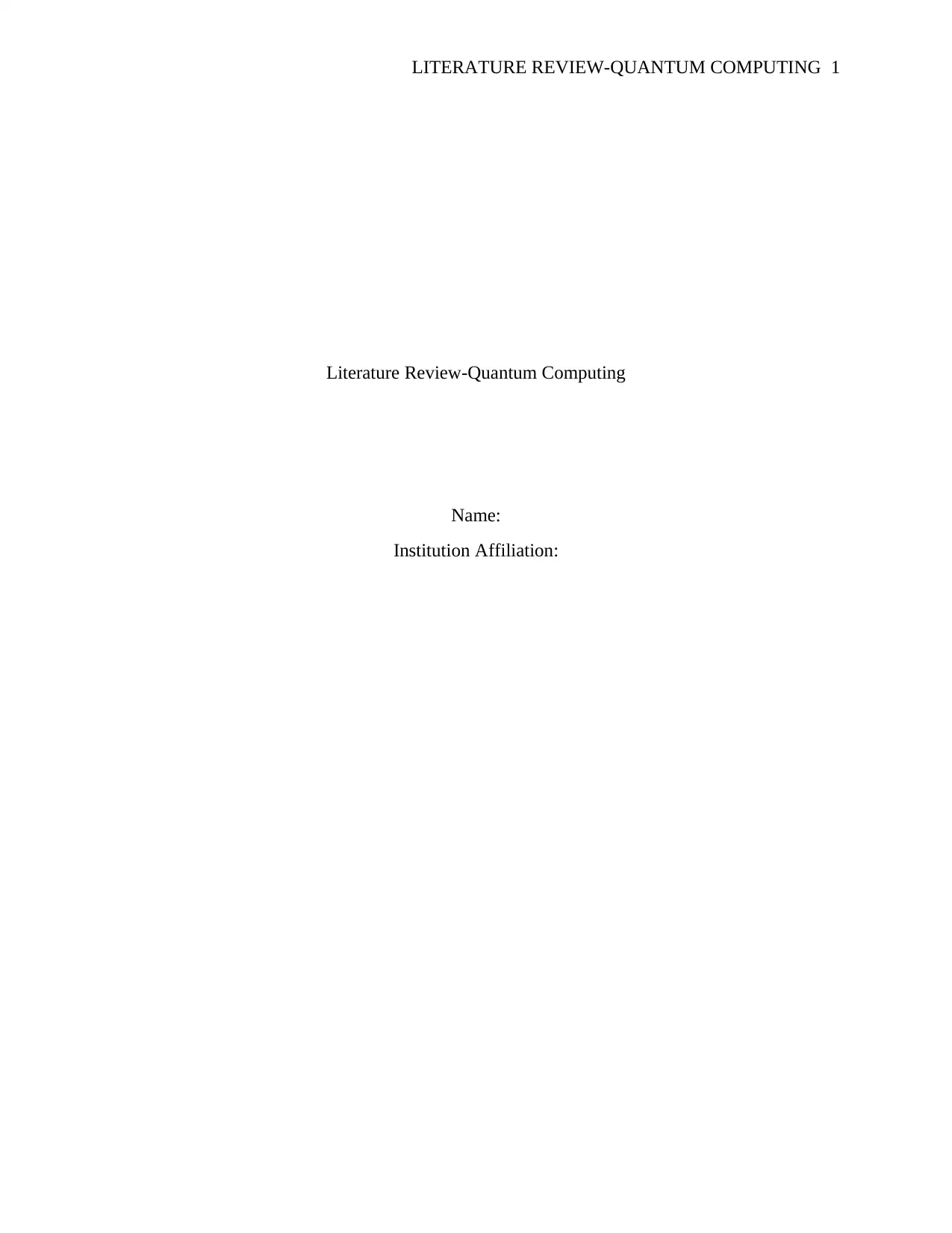
LITERATURE REVIEW-QUANTUM COMPUTING 1
Literature Review-Quantum Computing
Name:
Institution Affiliation:
Literature Review-Quantum Computing
Name:
Institution Affiliation:
Paraphrase This Document
Need a fresh take? Get an instant paraphrase of this document with our AI Paraphraser
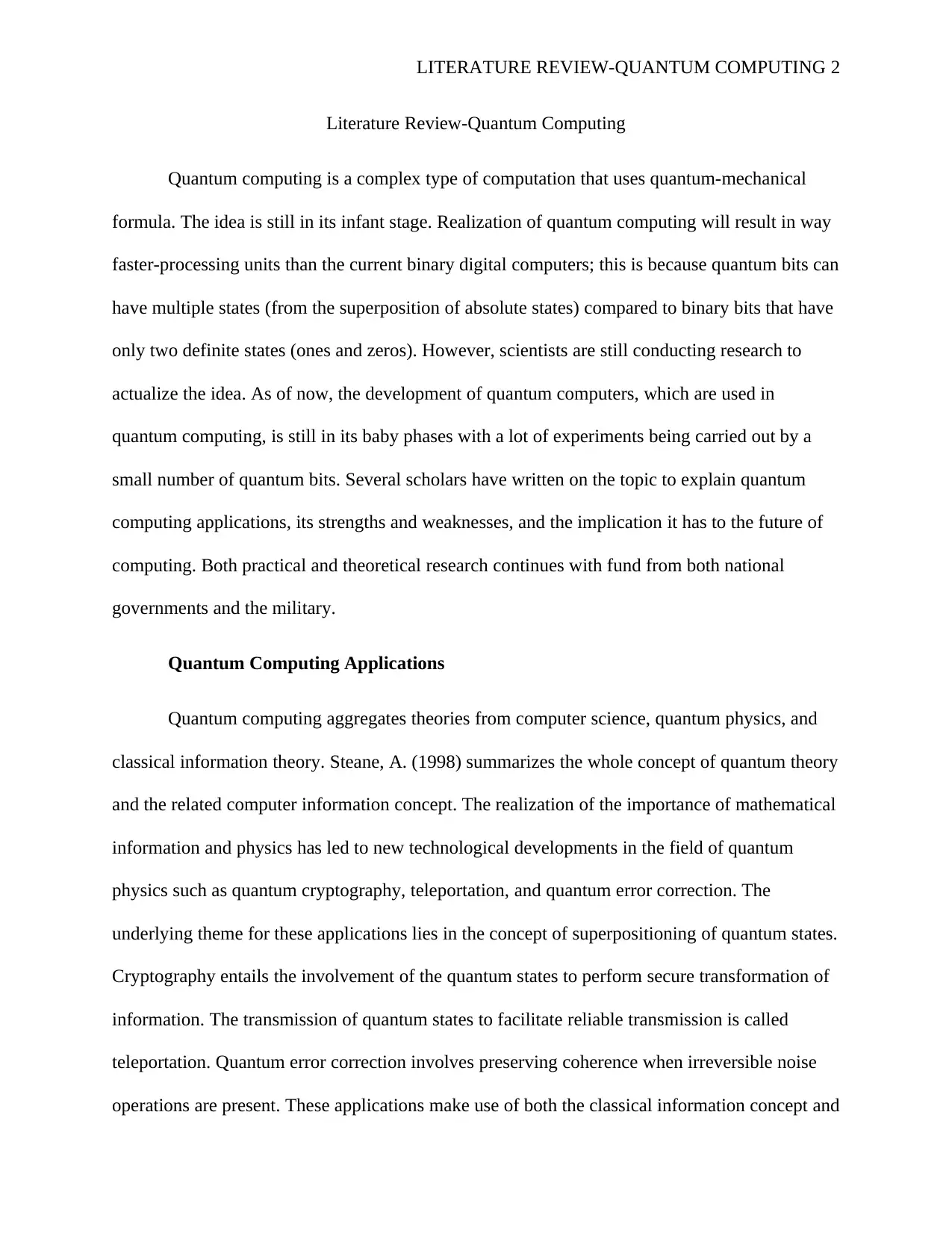
LITERATURE REVIEW-QUANTUM COMPUTING 2
Literature Review-Quantum Computing
Quantum computing is a complex type of computation that uses quantum-mechanical
formula. The idea is still in its infant stage. Realization of quantum computing will result in way
faster-processing units than the current binary digital computers; this is because quantum bits can
have multiple states (from the superposition of absolute states) compared to binary bits that have
only two definite states (ones and zeros). However, scientists are still conducting research to
actualize the idea. As of now, the development of quantum computers, which are used in
quantum computing, is still in its baby phases with a lot of experiments being carried out by a
small number of quantum bits. Several scholars have written on the topic to explain quantum
computing applications, its strengths and weaknesses, and the implication it has to the future of
computing. Both practical and theoretical research continues with fund from both national
governments and the military.
Quantum Computing Applications
Quantum computing aggregates theories from computer science, quantum physics, and
classical information theory. Steane, A. (1998) summarizes the whole concept of quantum theory
and the related computer information concept. The realization of the importance of mathematical
information and physics has led to new technological developments in the field of quantum
physics such as quantum cryptography, teleportation, and quantum error correction. The
underlying theme for these applications lies in the concept of superpositioning of quantum states.
Cryptography entails the involvement of the quantum states to perform secure transformation of
information. The transmission of quantum states to facilitate reliable transmission is called
teleportation. Quantum error correction involves preserving coherence when irreversible noise
operations are present. These applications make use of both the classical information concept and
Literature Review-Quantum Computing
Quantum computing is a complex type of computation that uses quantum-mechanical
formula. The idea is still in its infant stage. Realization of quantum computing will result in way
faster-processing units than the current binary digital computers; this is because quantum bits can
have multiple states (from the superposition of absolute states) compared to binary bits that have
only two definite states (ones and zeros). However, scientists are still conducting research to
actualize the idea. As of now, the development of quantum computers, which are used in
quantum computing, is still in its baby phases with a lot of experiments being carried out by a
small number of quantum bits. Several scholars have written on the topic to explain quantum
computing applications, its strengths and weaknesses, and the implication it has to the future of
computing. Both practical and theoretical research continues with fund from both national
governments and the military.
Quantum Computing Applications
Quantum computing aggregates theories from computer science, quantum physics, and
classical information theory. Steane, A. (1998) summarizes the whole concept of quantum theory
and the related computer information concept. The realization of the importance of mathematical
information and physics has led to new technological developments in the field of quantum
physics such as quantum cryptography, teleportation, and quantum error correction. The
underlying theme for these applications lies in the concept of superpositioning of quantum states.
Cryptography entails the involvement of the quantum states to perform secure transformation of
information. The transmission of quantum states to facilitate reliable transmission is called
teleportation. Quantum error correction involves preserving coherence when irreversible noise
operations are present. These applications make use of both the classical information concept and
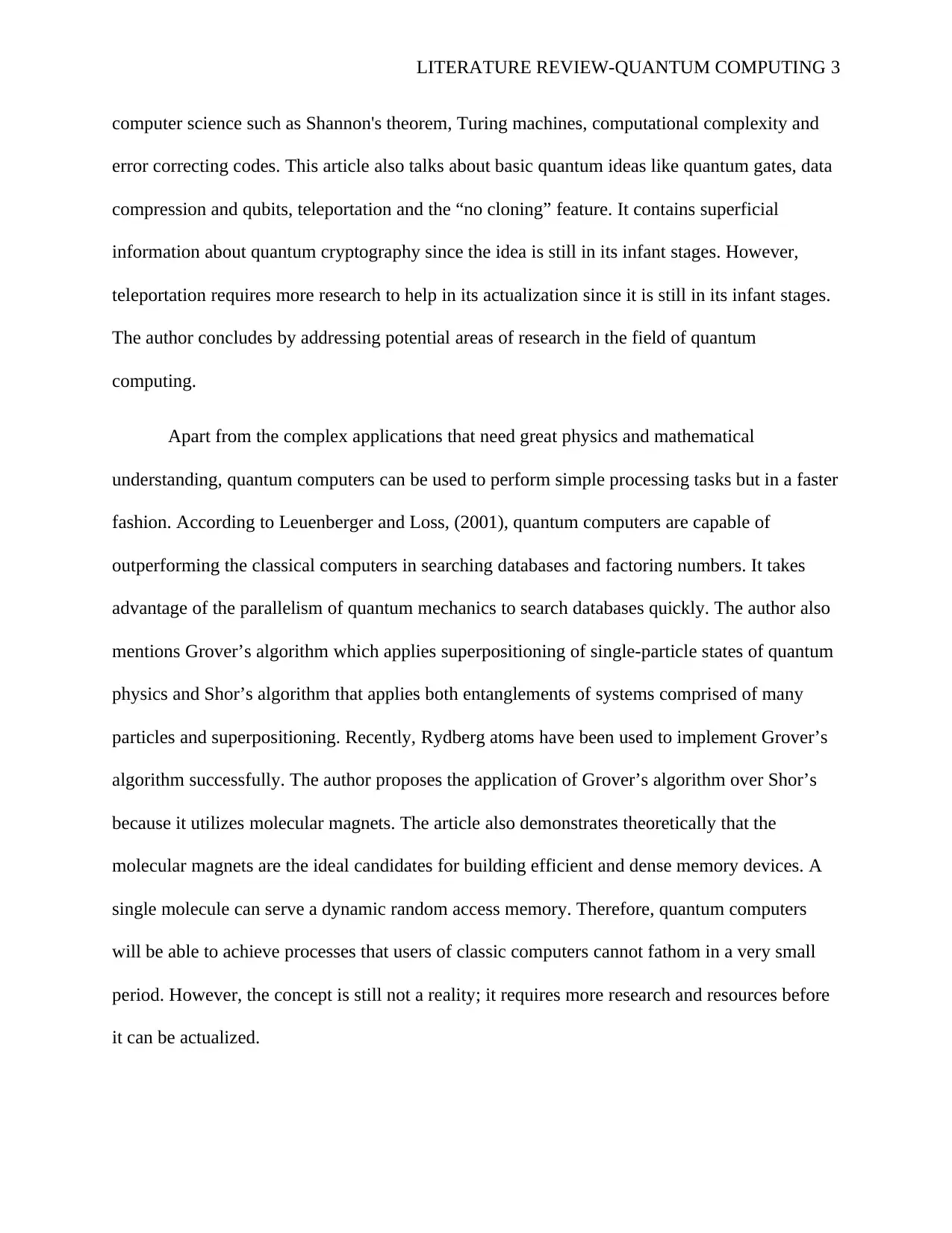
LITERATURE REVIEW-QUANTUM COMPUTING 3
computer science such as Shannon's theorem, Turing machines, computational complexity and
error correcting codes. This article also talks about basic quantum ideas like quantum gates, data
compression and qubits, teleportation and the “no cloning” feature. It contains superficial
information about quantum cryptography since the idea is still in its infant stages. However,
teleportation requires more research to help in its actualization since it is still in its infant stages.
The author concludes by addressing potential areas of research in the field of quantum
computing.
Apart from the complex applications that need great physics and mathematical
understanding, quantum computers can be used to perform simple processing tasks but in a faster
fashion. According to Leuenberger and Loss, (2001), quantum computers are capable of
outperforming the classical computers in searching databases and factoring numbers. It takes
advantage of the parallelism of quantum mechanics to search databases quickly. The author also
mentions Grover’s algorithm which applies superpositioning of single-particle states of quantum
physics and Shor’s algorithm that applies both entanglements of systems comprised of many
particles and superpositioning. Recently, Rydberg atoms have been used to implement Grover’s
algorithm successfully. The author proposes the application of Grover’s algorithm over Shor’s
because it utilizes molecular magnets. The article also demonstrates theoretically that the
molecular magnets are the ideal candidates for building efficient and dense memory devices. A
single molecule can serve a dynamic random access memory. Therefore, quantum computers
will be able to achieve processes that users of classic computers cannot fathom in a very small
period. However, the concept is still not a reality; it requires more research and resources before
it can be actualized.
computer science such as Shannon's theorem, Turing machines, computational complexity and
error correcting codes. This article also talks about basic quantum ideas like quantum gates, data
compression and qubits, teleportation and the “no cloning” feature. It contains superficial
information about quantum cryptography since the idea is still in its infant stages. However,
teleportation requires more research to help in its actualization since it is still in its infant stages.
The author concludes by addressing potential areas of research in the field of quantum
computing.
Apart from the complex applications that need great physics and mathematical
understanding, quantum computers can be used to perform simple processing tasks but in a faster
fashion. According to Leuenberger and Loss, (2001), quantum computers are capable of
outperforming the classical computers in searching databases and factoring numbers. It takes
advantage of the parallelism of quantum mechanics to search databases quickly. The author also
mentions Grover’s algorithm which applies superpositioning of single-particle states of quantum
physics and Shor’s algorithm that applies both entanglements of systems comprised of many
particles and superpositioning. Recently, Rydberg atoms have been used to implement Grover’s
algorithm successfully. The author proposes the application of Grover’s algorithm over Shor’s
because it utilizes molecular magnets. The article also demonstrates theoretically that the
molecular magnets are the ideal candidates for building efficient and dense memory devices. A
single molecule can serve a dynamic random access memory. Therefore, quantum computers
will be able to achieve processes that users of classic computers cannot fathom in a very small
period. However, the concept is still not a reality; it requires more research and resources before
it can be actualized.
⊘ This is a preview!⊘
Do you want full access?
Subscribe today to unlock all pages.

Trusted by 1+ million students worldwide
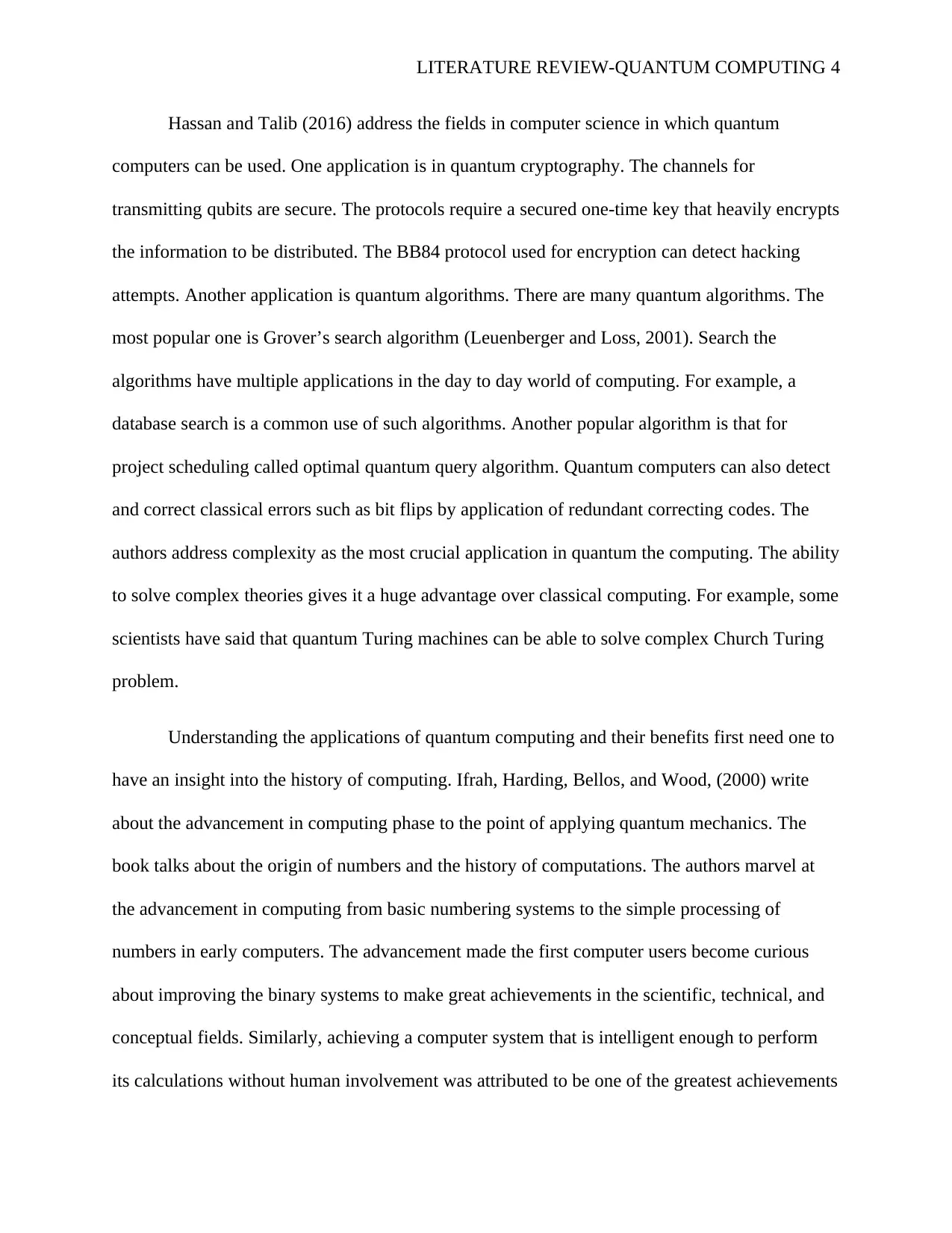
LITERATURE REVIEW-QUANTUM COMPUTING 4
Hassan and Talib (2016) address the fields in computer science in which quantum
computers can be used. One application is in quantum cryptography. The channels for
transmitting qubits are secure. The protocols require a secured one-time key that heavily encrypts
the information to be distributed. The BB84 protocol used for encryption can detect hacking
attempts. Another application is quantum algorithms. There are many quantum algorithms. The
most popular one is Grover’s search algorithm (Leuenberger and Loss, 2001). Search the
algorithms have multiple applications in the day to day world of computing. For example, a
database search is a common use of such algorithms. Another popular algorithm is that for
project scheduling called optimal quantum query algorithm. Quantum computers can also detect
and correct classical errors such as bit flips by application of redundant correcting codes. The
authors address complexity as the most crucial application in quantum the computing. The ability
to solve complex theories gives it a huge advantage over classical computing. For example, some
scientists have said that quantum Turing machines can be able to solve complex Church Turing
problem.
Understanding the applications of quantum computing and their benefits first need one to
have an insight into the history of computing. Ifrah, Harding, Bellos, and Wood, (2000) write
about the advancement in computing phase to the point of applying quantum mechanics. The
book talks about the origin of numbers and the history of computations. The authors marvel at
the advancement in computing from basic numbering systems to the simple processing of
numbers in early computers. The advancement made the first computer users become curious
about improving the binary systems to make great achievements in the scientific, technical, and
conceptual fields. Similarly, achieving a computer system that is intelligent enough to perform
its calculations without human involvement was attributed to be one of the greatest achievements
Hassan and Talib (2016) address the fields in computer science in which quantum
computers can be used. One application is in quantum cryptography. The channels for
transmitting qubits are secure. The protocols require a secured one-time key that heavily encrypts
the information to be distributed. The BB84 protocol used for encryption can detect hacking
attempts. Another application is quantum algorithms. There are many quantum algorithms. The
most popular one is Grover’s search algorithm (Leuenberger and Loss, 2001). Search the
algorithms have multiple applications in the day to day world of computing. For example, a
database search is a common use of such algorithms. Another popular algorithm is that for
project scheduling called optimal quantum query algorithm. Quantum computers can also detect
and correct classical errors such as bit flips by application of redundant correcting codes. The
authors address complexity as the most crucial application in quantum the computing. The ability
to solve complex theories gives it a huge advantage over classical computing. For example, some
scientists have said that quantum Turing machines can be able to solve complex Church Turing
problem.
Understanding the applications of quantum computing and their benefits first need one to
have an insight into the history of computing. Ifrah, Harding, Bellos, and Wood, (2000) write
about the advancement in computing phase to the point of applying quantum mechanics. The
book talks about the origin of numbers and the history of computations. The authors marvel at
the advancement in computing from basic numbering systems to the simple processing of
numbers in early computers. The advancement made the first computer users become curious
about improving the binary systems to make great achievements in the scientific, technical, and
conceptual fields. Similarly, achieving a computer system that is intelligent enough to perform
its calculations without human involvement was attributed to be one of the greatest achievements
Paraphrase This Document
Need a fresh take? Get an instant paraphrase of this document with our AI Paraphraser
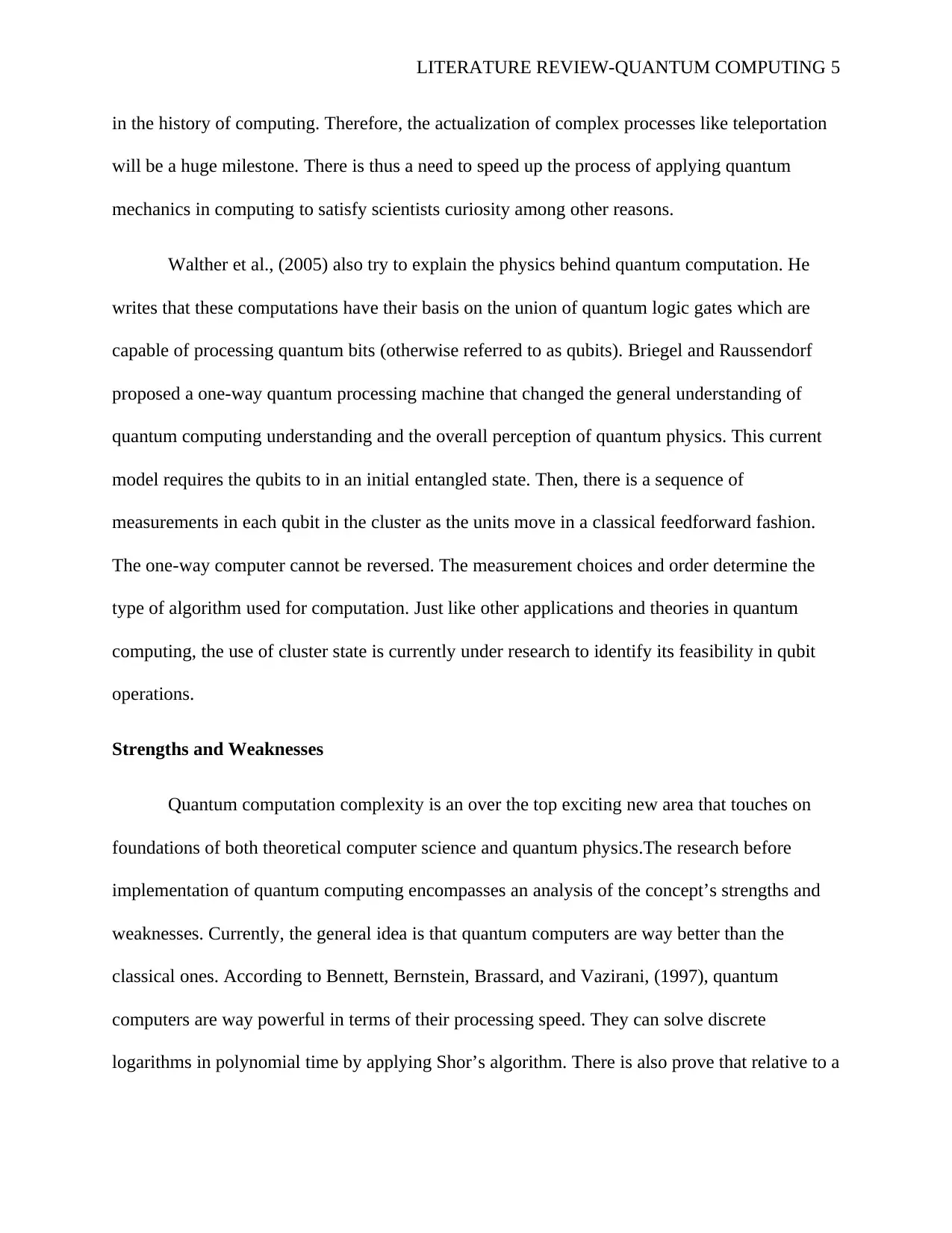
LITERATURE REVIEW-QUANTUM COMPUTING 5
in the history of computing. Therefore, the actualization of complex processes like teleportation
will be a huge milestone. There is thus a need to speed up the process of applying quantum
mechanics in computing to satisfy scientists curiosity among other reasons.
Walther et al., (2005) also try to explain the physics behind quantum computation. He
writes that these computations have their basis on the union of quantum logic gates which are
capable of processing quantum bits (otherwise referred to as qubits). Briegel and Raussendorf
proposed a one-way quantum processing machine that changed the general understanding of
quantum computing understanding and the overall perception of quantum physics. This current
model requires the qubits to in an initial entangled state. Then, there is a sequence of
measurements in each qubit in the cluster as the units move in a classical feedforward fashion.
The one-way computer cannot be reversed. The measurement choices and order determine the
type of algorithm used for computation. Just like other applications and theories in quantum
computing, the use of cluster state is currently under research to identify its feasibility in qubit
operations.
Strengths and Weaknesses
Quantum computation complexity is an over the top exciting new area that touches on
foundations of both theoretical computer science and quantum physics.The research before
implementation of quantum computing encompasses an analysis of the concept’s strengths and
weaknesses. Currently, the general idea is that quantum computers are way better than the
classical ones. According to Bennett, Bernstein, Brassard, and Vazirani, (1997), quantum
computers are way powerful in terms of their processing speed. They can solve discrete
logarithms in polynomial time by applying Shor’s algorithm. There is also prove that relative to a
in the history of computing. Therefore, the actualization of complex processes like teleportation
will be a huge milestone. There is thus a need to speed up the process of applying quantum
mechanics in computing to satisfy scientists curiosity among other reasons.
Walther et al., (2005) also try to explain the physics behind quantum computation. He
writes that these computations have their basis on the union of quantum logic gates which are
capable of processing quantum bits (otherwise referred to as qubits). Briegel and Raussendorf
proposed a one-way quantum processing machine that changed the general understanding of
quantum computing understanding and the overall perception of quantum physics. This current
model requires the qubits to in an initial entangled state. Then, there is a sequence of
measurements in each qubit in the cluster as the units move in a classical feedforward fashion.
The one-way computer cannot be reversed. The measurement choices and order determine the
type of algorithm used for computation. Just like other applications and theories in quantum
computing, the use of cluster state is currently under research to identify its feasibility in qubit
operations.
Strengths and Weaknesses
Quantum computation complexity is an over the top exciting new area that touches on
foundations of both theoretical computer science and quantum physics.The research before
implementation of quantum computing encompasses an analysis of the concept’s strengths and
weaknesses. Currently, the general idea is that quantum computers are way better than the
classical ones. According to Bennett, Bernstein, Brassard, and Vazirani, (1997), quantum
computers are way powerful in terms of their processing speed. They can solve discrete
logarithms in polynomial time by applying Shor’s algorithm. There is also prove that relative to a
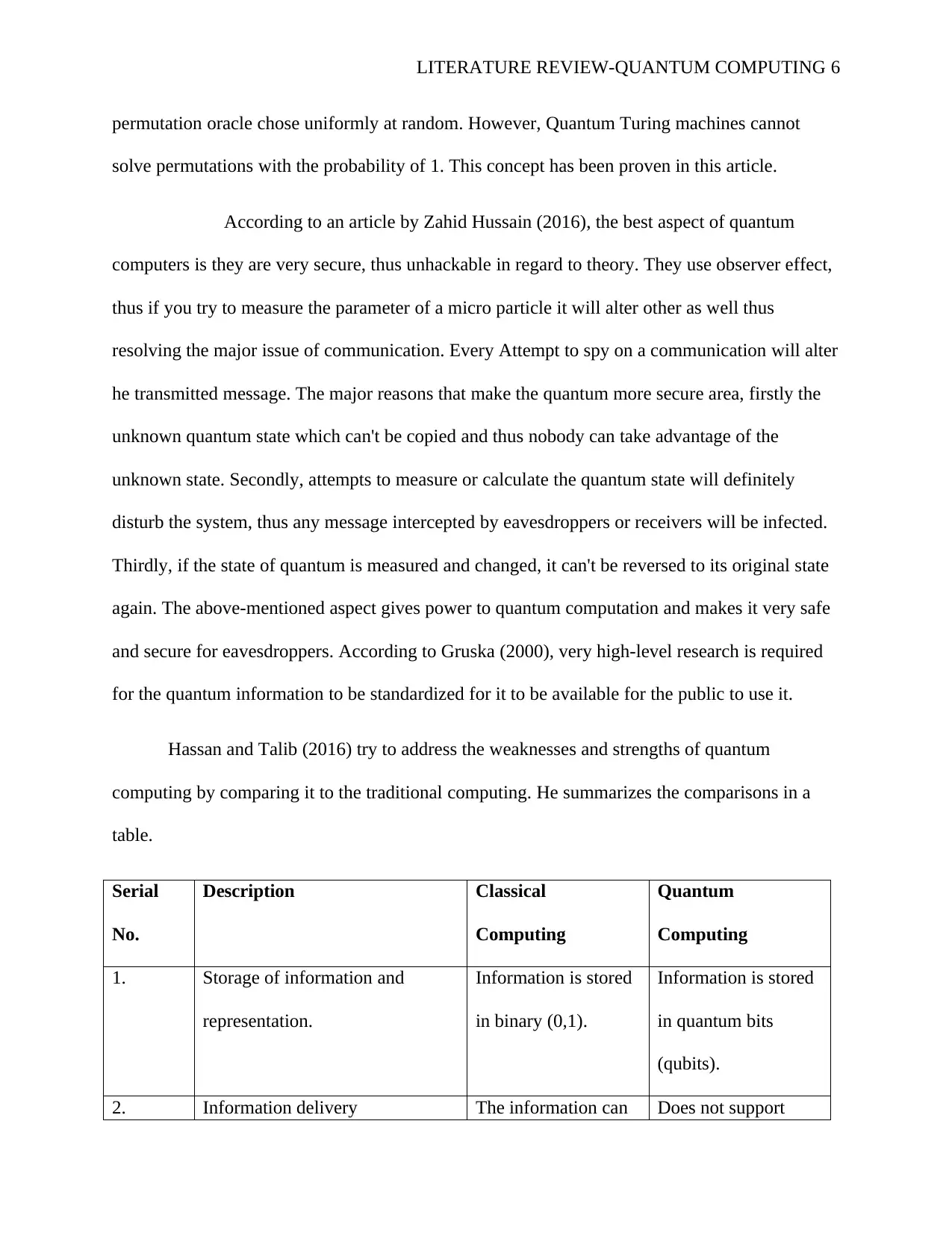
LITERATURE REVIEW-QUANTUM COMPUTING 6
permutation oracle chose uniformly at random. However, Quantum Turing machines cannot
solve permutations with the probability of 1. This concept has been proven in this article.
According to an article by Zahid Hussain (2016), the best aspect of quantum
computers is they are very secure, thus unhackable in regard to theory. They use observer effect,
thus if you try to measure the parameter of a micro particle it will alter other as well thus
resolving the major issue of communication. Every Attempt to spy on a communication will alter
he transmitted message. The major reasons that make the quantum more secure area, firstly the
unknown quantum state which can't be copied and thus nobody can take advantage of the
unknown state. Secondly, attempts to measure or calculate the quantum state will definitely
disturb the system, thus any message intercepted by eavesdroppers or receivers will be infected.
Thirdly, if the state of quantum is measured and changed, it can't be reversed to its original state
again. The above-mentioned aspect gives power to quantum computation and makes it very safe
and secure for eavesdroppers. According to Gruska (2000), very high-level research is required
for the quantum information to be standardized for it to be available for the public to use it.
Hassan and Talib (2016) try to address the weaknesses and strengths of quantum
computing by comparing it to the traditional computing. He summarizes the comparisons in a
table.
Serial
No.
Description Classical
Computing
Quantum
Computing
1. Storage of information and
representation.
Information is stored
in binary (0,1).
Information is stored
in quantum bits
(qubits).
2. Information delivery The information can Does not support
permutation oracle chose uniformly at random. However, Quantum Turing machines cannot
solve permutations with the probability of 1. This concept has been proven in this article.
According to an article by Zahid Hussain (2016), the best aspect of quantum
computers is they are very secure, thus unhackable in regard to theory. They use observer effect,
thus if you try to measure the parameter of a micro particle it will alter other as well thus
resolving the major issue of communication. Every Attempt to spy on a communication will alter
he transmitted message. The major reasons that make the quantum more secure area, firstly the
unknown quantum state which can't be copied and thus nobody can take advantage of the
unknown state. Secondly, attempts to measure or calculate the quantum state will definitely
disturb the system, thus any message intercepted by eavesdroppers or receivers will be infected.
Thirdly, if the state of quantum is measured and changed, it can't be reversed to its original state
again. The above-mentioned aspect gives power to quantum computation and makes it very safe
and secure for eavesdroppers. According to Gruska (2000), very high-level research is required
for the quantum information to be standardized for it to be available for the public to use it.
Hassan and Talib (2016) try to address the weaknesses and strengths of quantum
computing by comparing it to the traditional computing. He summarizes the comparisons in a
table.
Serial
No.
Description Classical
Computing
Quantum
Computing
1. Storage of information and
representation.
Information is stored
in binary (0,1).
Information is stored
in quantum bits
(qubits).
2. Information delivery The information can Does not support
⊘ This is a preview!⊘
Do you want full access?
Subscribe today to unlock all pages.

Trusted by 1+ million students worldwide
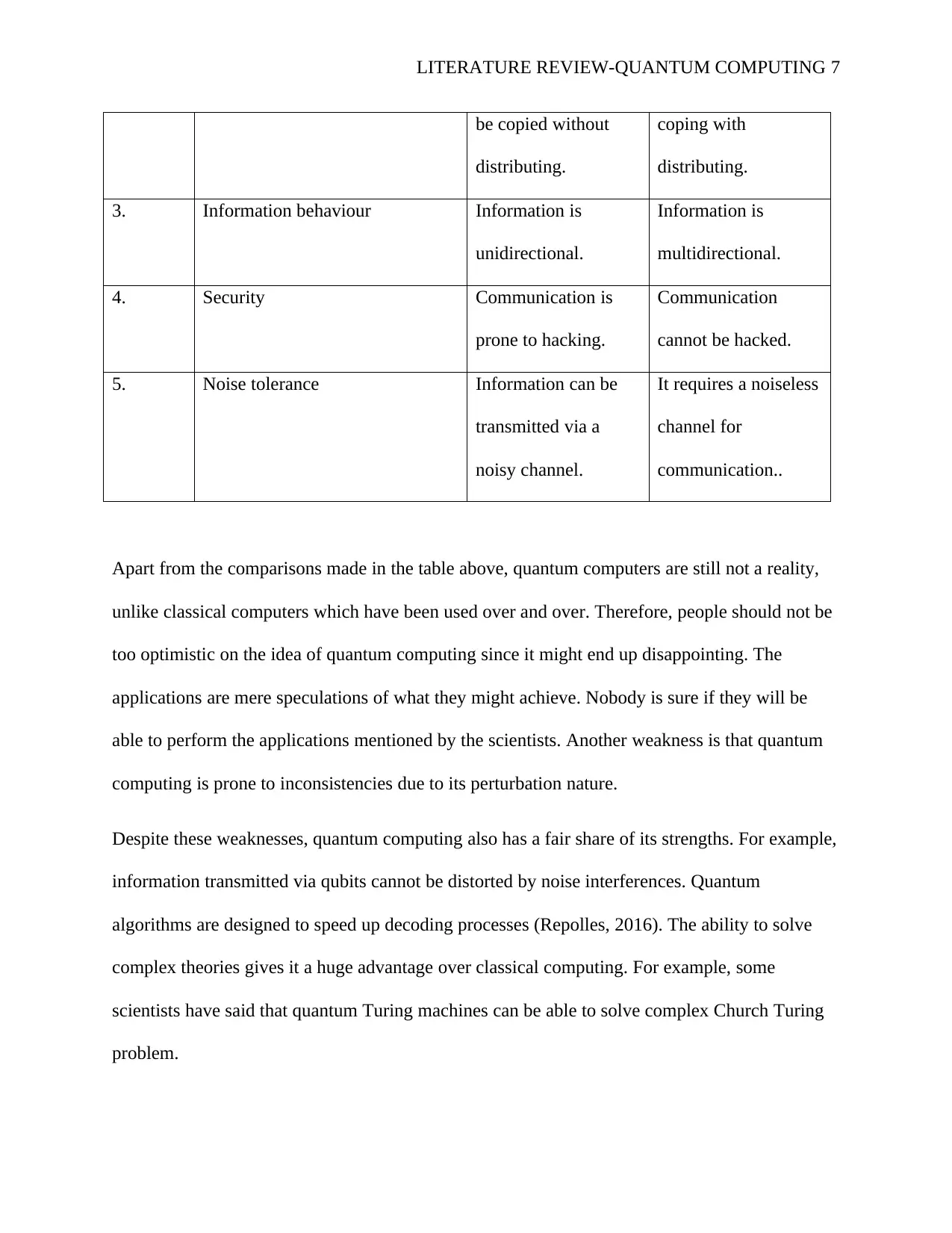
LITERATURE REVIEW-QUANTUM COMPUTING 7
be copied without
distributing.
coping with
distributing.
3. Information behaviour Information is
unidirectional.
Information is
multidirectional.
4. Security Communication is
prone to hacking.
Communication
cannot be hacked.
5. Noise tolerance Information can be
transmitted via a
noisy channel.
It requires a noiseless
channel for
communication..
Apart from the comparisons made in the table above, quantum computers are still not a reality,
unlike classical computers which have been used over and over. Therefore, people should not be
too optimistic on the idea of quantum computing since it might end up disappointing. The
applications are mere speculations of what they might achieve. Nobody is sure if they will be
able to perform the applications mentioned by the scientists. Another weakness is that quantum
computing is prone to inconsistencies due to its perturbation nature.
Despite these weaknesses, quantum computing also has a fair share of its strengths. For example,
information transmitted via qubits cannot be distorted by noise interferences. Quantum
algorithms are designed to speed up decoding processes (Repolles, 2016). The ability to solve
complex theories gives it a huge advantage over classical computing. For example, some
scientists have said that quantum Turing machines can be able to solve complex Church Turing
problem.
be copied without
distributing.
coping with
distributing.
3. Information behaviour Information is
unidirectional.
Information is
multidirectional.
4. Security Communication is
prone to hacking.
Communication
cannot be hacked.
5. Noise tolerance Information can be
transmitted via a
noisy channel.
It requires a noiseless
channel for
communication..
Apart from the comparisons made in the table above, quantum computers are still not a reality,
unlike classical computers which have been used over and over. Therefore, people should not be
too optimistic on the idea of quantum computing since it might end up disappointing. The
applications are mere speculations of what they might achieve. Nobody is sure if they will be
able to perform the applications mentioned by the scientists. Another weakness is that quantum
computing is prone to inconsistencies due to its perturbation nature.
Despite these weaknesses, quantum computing also has a fair share of its strengths. For example,
information transmitted via qubits cannot be distorted by noise interferences. Quantum
algorithms are designed to speed up decoding processes (Repolles, 2016). The ability to solve
complex theories gives it a huge advantage over classical computing. For example, some
scientists have said that quantum Turing machines can be able to solve complex Church Turing
problem.
Paraphrase This Document
Need a fresh take? Get an instant paraphrase of this document with our AI Paraphraser
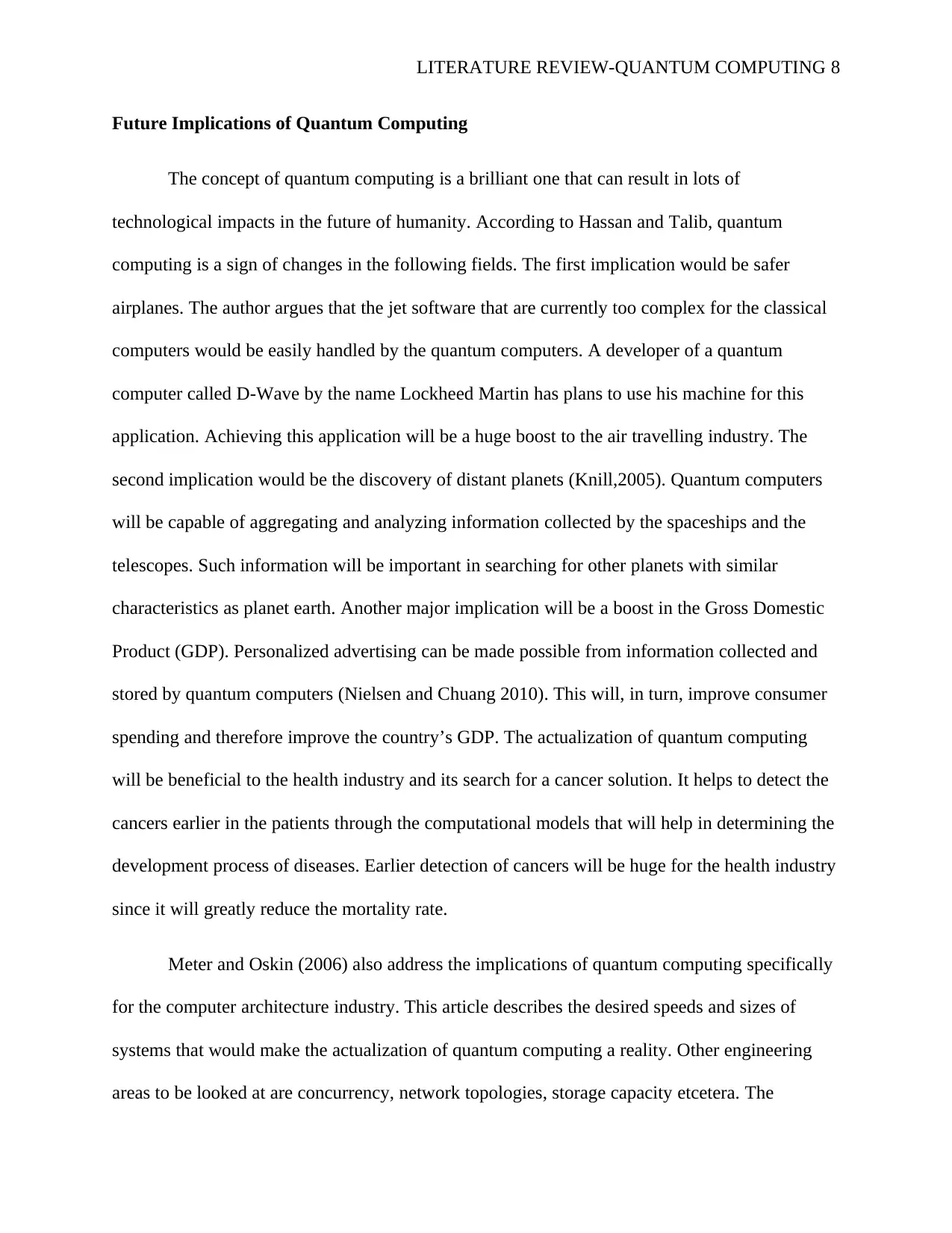
LITERATURE REVIEW-QUANTUM COMPUTING 8
Future Implications of Quantum Computing
The concept of quantum computing is a brilliant one that can result in lots of
technological impacts in the future of humanity. According to Hassan and Talib, quantum
computing is a sign of changes in the following fields. The first implication would be safer
airplanes. The author argues that the jet software that are currently too complex for the classical
computers would be easily handled by the quantum computers. A developer of a quantum
computer called D-Wave by the name Lockheed Martin has plans to use his machine for this
application. Achieving this application will be a huge boost to the air travelling industry. The
second implication would be the discovery of distant planets (Knill,2005). Quantum computers
will be capable of aggregating and analyzing information collected by the spaceships and the
telescopes. Such information will be important in searching for other planets with similar
characteristics as planet earth. Another major implication will be a boost in the Gross Domestic
Product (GDP). Personalized advertising can be made possible from information collected and
stored by quantum computers (Nielsen and Chuang 2010). This will, in turn, improve consumer
spending and therefore improve the country’s GDP. The actualization of quantum computing
will be beneficial to the health industry and its search for a cancer solution. It helps to detect the
cancers earlier in the patients through the computational models that will help in determining the
development process of diseases. Earlier detection of cancers will be huge for the health industry
since it will greatly reduce the mortality rate.
Meter and Oskin (2006) also address the implications of quantum computing specifically
for the computer architecture industry. This article describes the desired speeds and sizes of
systems that would make the actualization of quantum computing a reality. Other engineering
areas to be looked at are concurrency, network topologies, storage capacity etcetera. The
Future Implications of Quantum Computing
The concept of quantum computing is a brilliant one that can result in lots of
technological impacts in the future of humanity. According to Hassan and Talib, quantum
computing is a sign of changes in the following fields. The first implication would be safer
airplanes. The author argues that the jet software that are currently too complex for the classical
computers would be easily handled by the quantum computers. A developer of a quantum
computer called D-Wave by the name Lockheed Martin has plans to use his machine for this
application. Achieving this application will be a huge boost to the air travelling industry. The
second implication would be the discovery of distant planets (Knill,2005). Quantum computers
will be capable of aggregating and analyzing information collected by the spaceships and the
telescopes. Such information will be important in searching for other planets with similar
characteristics as planet earth. Another major implication will be a boost in the Gross Domestic
Product (GDP). Personalized advertising can be made possible from information collected and
stored by quantum computers (Nielsen and Chuang 2010). This will, in turn, improve consumer
spending and therefore improve the country’s GDP. The actualization of quantum computing
will be beneficial to the health industry and its search for a cancer solution. It helps to detect the
cancers earlier in the patients through the computational models that will help in determining the
development process of diseases. Earlier detection of cancers will be huge for the health industry
since it will greatly reduce the mortality rate.
Meter and Oskin (2006) also address the implications of quantum computing specifically
for the computer architecture industry. This article describes the desired speeds and sizes of
systems that would make the actualization of quantum computing a reality. Other engineering
areas to be looked at are concurrency, network topologies, storage capacity etcetera. The
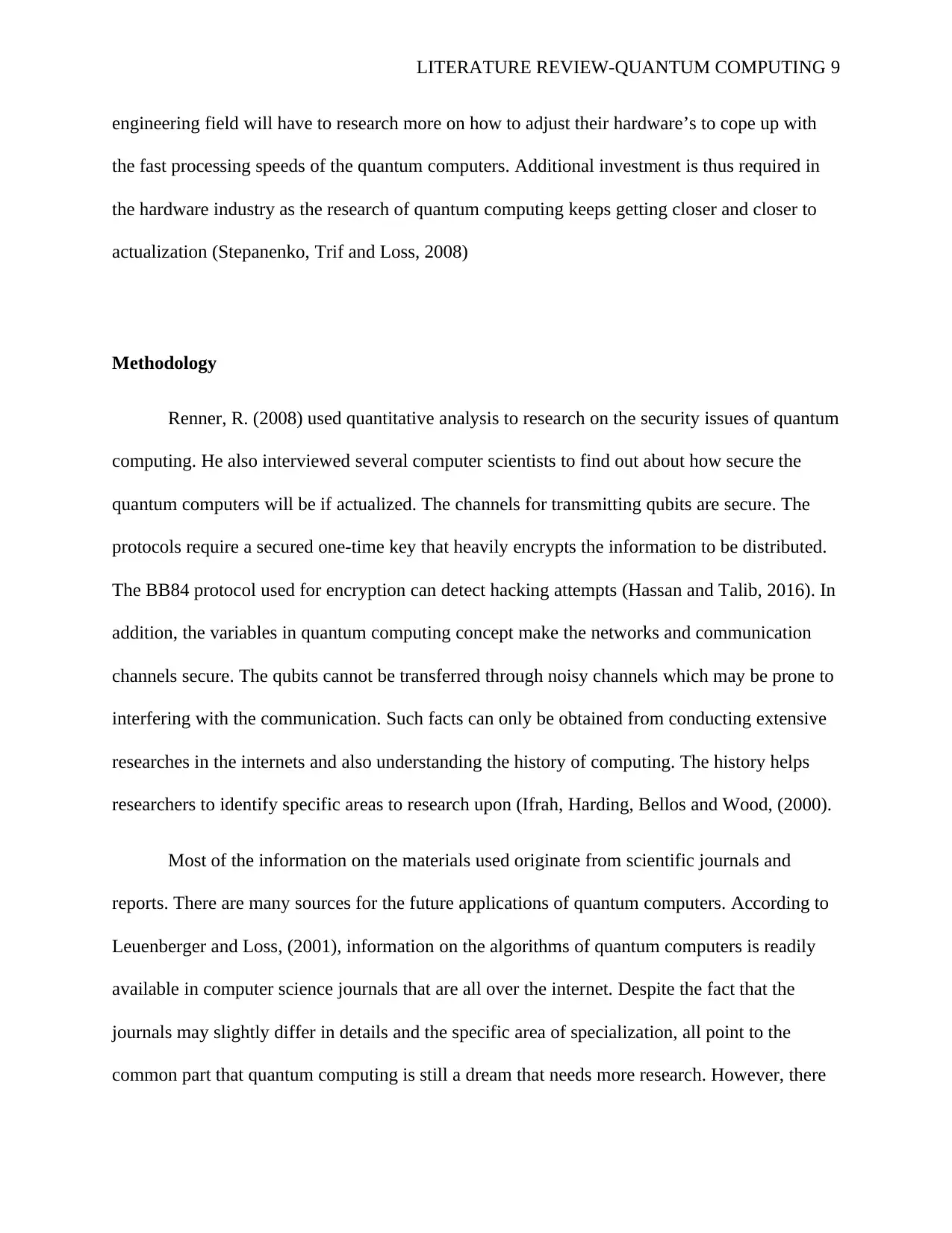
LITERATURE REVIEW-QUANTUM COMPUTING 9
engineering field will have to research more on how to adjust their hardware’s to cope up with
the fast processing speeds of the quantum computers. Additional investment is thus required in
the hardware industry as the research of quantum computing keeps getting closer and closer to
actualization (Stepanenko, Trif and Loss, 2008)
Methodology
Renner, R. (2008) used quantitative analysis to research on the security issues of quantum
computing. He also interviewed several computer scientists to find out about how secure the
quantum computers will be if actualized. The channels for transmitting qubits are secure. The
protocols require a secured one-time key that heavily encrypts the information to be distributed.
The BB84 protocol used for encryption can detect hacking attempts (Hassan and Talib, 2016). In
addition, the variables in quantum computing concept make the networks and communication
channels secure. The qubits cannot be transferred through noisy channels which may be prone to
interfering with the communication. Such facts can only be obtained from conducting extensive
researches in the internets and also understanding the history of computing. The history helps
researchers to identify specific areas to research upon (Ifrah, Harding, Bellos and Wood, (2000).
Most of the information on the materials used originate from scientific journals and
reports. There are many sources for the future applications of quantum computers. According to
Leuenberger and Loss, (2001), information on the algorithms of quantum computers is readily
available in computer science journals that are all over the internet. Despite the fact that the
journals may slightly differ in details and the specific area of specialization, all point to the
common part that quantum computing is still a dream that needs more research. However, there
engineering field will have to research more on how to adjust their hardware’s to cope up with
the fast processing speeds of the quantum computers. Additional investment is thus required in
the hardware industry as the research of quantum computing keeps getting closer and closer to
actualization (Stepanenko, Trif and Loss, 2008)
Methodology
Renner, R. (2008) used quantitative analysis to research on the security issues of quantum
computing. He also interviewed several computer scientists to find out about how secure the
quantum computers will be if actualized. The channels for transmitting qubits are secure. The
protocols require a secured one-time key that heavily encrypts the information to be distributed.
The BB84 protocol used for encryption can detect hacking attempts (Hassan and Talib, 2016). In
addition, the variables in quantum computing concept make the networks and communication
channels secure. The qubits cannot be transferred through noisy channels which may be prone to
interfering with the communication. Such facts can only be obtained from conducting extensive
researches in the internets and also understanding the history of computing. The history helps
researchers to identify specific areas to research upon (Ifrah, Harding, Bellos and Wood, (2000).
Most of the information on the materials used originate from scientific journals and
reports. There are many sources for the future applications of quantum computers. According to
Leuenberger and Loss, (2001), information on the algorithms of quantum computers is readily
available in computer science journals that are all over the internet. Despite the fact that the
journals may slightly differ in details and the specific area of specialization, all point to the
common part that quantum computing is still a dream that needs more research. However, there
⊘ This is a preview!⊘
Do you want full access?
Subscribe today to unlock all pages.

Trusted by 1+ million students worldwide
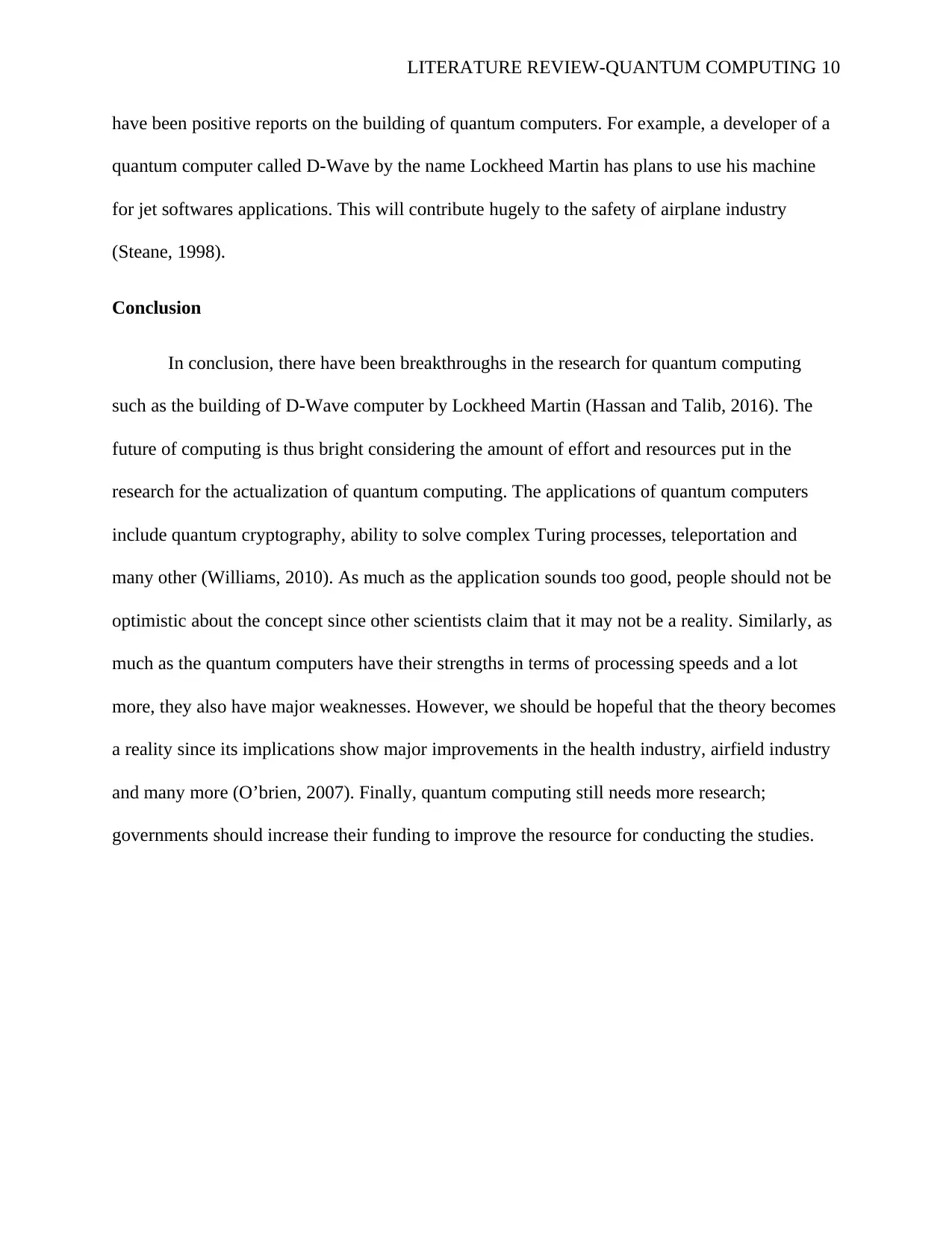
LITERATURE REVIEW-QUANTUM COMPUTING 10
have been positive reports on the building of quantum computers. For example, a developer of a
quantum computer called D-Wave by the name Lockheed Martin has plans to use his machine
for jet softwares applications. This will contribute hugely to the safety of airplane industry
(Steane, 1998).
Conclusion
In conclusion, there have been breakthroughs in the research for quantum computing
such as the building of D-Wave computer by Lockheed Martin (Hassan and Talib, 2016). The
future of computing is thus bright considering the amount of effort and resources put in the
research for the actualization of quantum computing. The applications of quantum computers
include quantum cryptography, ability to solve complex Turing processes, teleportation and
many other (Williams, 2010). As much as the application sounds too good, people should not be
optimistic about the concept since other scientists claim that it may not be a reality. Similarly, as
much as the quantum computers have their strengths in terms of processing speeds and a lot
more, they also have major weaknesses. However, we should be hopeful that the theory becomes
a reality since its implications show major improvements in the health industry, airfield industry
and many more (O’brien, 2007). Finally, quantum computing still needs more research;
governments should increase their funding to improve the resource for conducting the studies.
have been positive reports on the building of quantum computers. For example, a developer of a
quantum computer called D-Wave by the name Lockheed Martin has plans to use his machine
for jet softwares applications. This will contribute hugely to the safety of airplane industry
(Steane, 1998).
Conclusion
In conclusion, there have been breakthroughs in the research for quantum computing
such as the building of D-Wave computer by Lockheed Martin (Hassan and Talib, 2016). The
future of computing is thus bright considering the amount of effort and resources put in the
research for the actualization of quantum computing. The applications of quantum computers
include quantum cryptography, ability to solve complex Turing processes, teleportation and
many other (Williams, 2010). As much as the application sounds too good, people should not be
optimistic about the concept since other scientists claim that it may not be a reality. Similarly, as
much as the quantum computers have their strengths in terms of processing speeds and a lot
more, they also have major weaknesses. However, we should be hopeful that the theory becomes
a reality since its implications show major improvements in the health industry, airfield industry
and many more (O’brien, 2007). Finally, quantum computing still needs more research;
governments should increase their funding to improve the resource for conducting the studies.
Paraphrase This Document
Need a fresh take? Get an instant paraphrase of this document with our AI Paraphraser
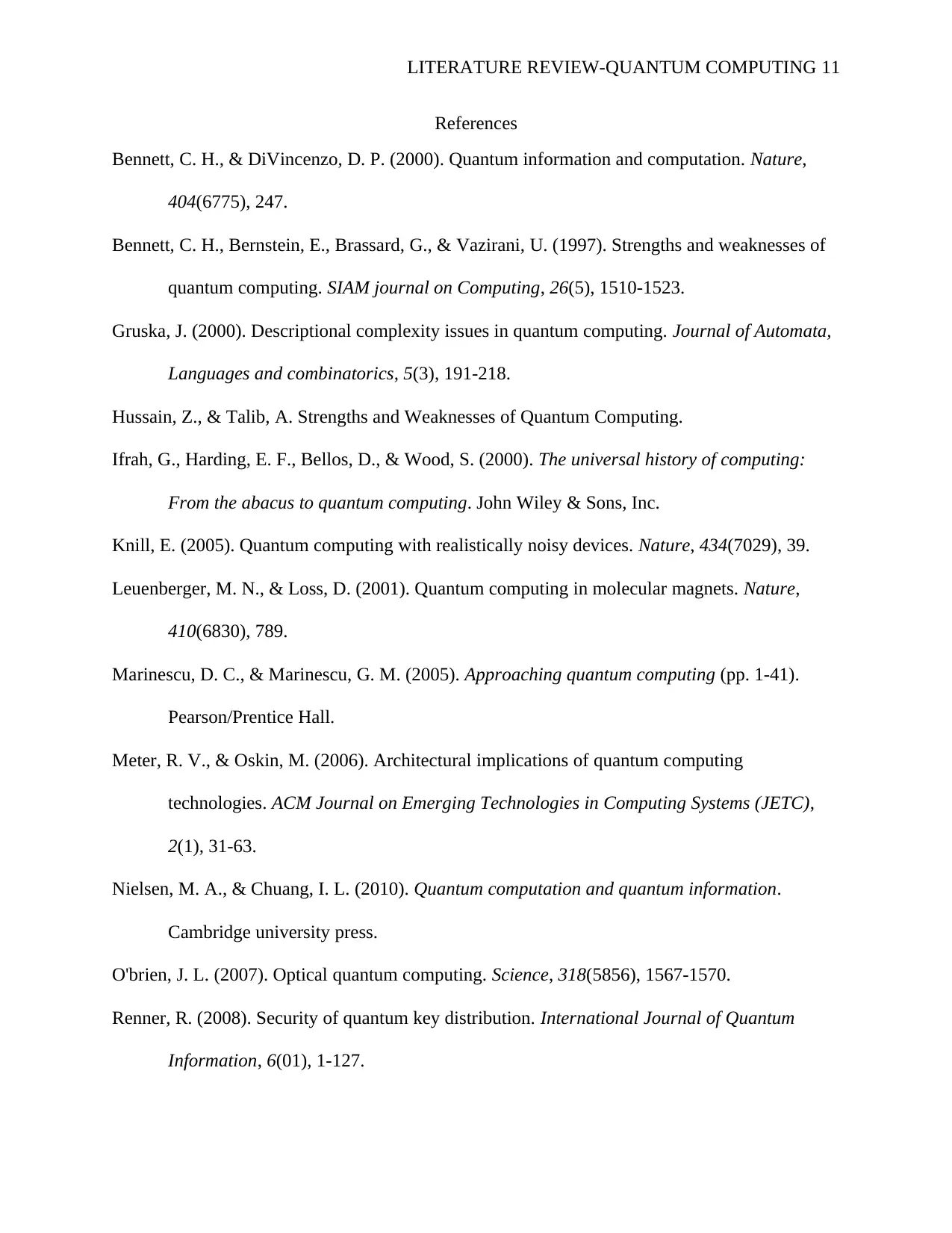
LITERATURE REVIEW-QUANTUM COMPUTING 11
References
Bennett, C. H., & DiVincenzo, D. P. (2000). Quantum information and computation. Nature,
404(6775), 247.
Bennett, C. H., Bernstein, E., Brassard, G., & Vazirani, U. (1997). Strengths and weaknesses of
quantum computing. SIAM journal on Computing, 26(5), 1510-1523.
Gruska, J. (2000). Descriptional complexity issues in quantum computing. Journal of Automata,
Languages and combinatorics, 5(3), 191-218.
Hussain, Z., & Talib, A. Strengths and Weaknesses of Quantum Computing.
Ifrah, G., Harding, E. F., Bellos, D., & Wood, S. (2000). The universal history of computing:
From the abacus to quantum computing. John Wiley & Sons, Inc.
Knill, E. (2005). Quantum computing with realistically noisy devices. Nature, 434(7029), 39.
Leuenberger, M. N., & Loss, D. (2001). Quantum computing in molecular magnets. Nature,
410(6830), 789.
Marinescu, D. C., & Marinescu, G. M. (2005). Approaching quantum computing (pp. 1-41).
Pearson/Prentice Hall.
Meter, R. V., & Oskin, M. (2006). Architectural implications of quantum computing
technologies. ACM Journal on Emerging Technologies in Computing Systems (JETC),
2(1), 31-63.
Nielsen, M. A., & Chuang, I. L. (2010). Quantum computation and quantum information.
Cambridge university press.
O'brien, J. L. (2007). Optical quantum computing. Science, 318(5856), 1567-1570.
Renner, R. (2008). Security of quantum key distribution. International Journal of Quantum
Information, 6(01), 1-127.
References
Bennett, C. H., & DiVincenzo, D. P. (2000). Quantum information and computation. Nature,
404(6775), 247.
Bennett, C. H., Bernstein, E., Brassard, G., & Vazirani, U. (1997). Strengths and weaknesses of
quantum computing. SIAM journal on Computing, 26(5), 1510-1523.
Gruska, J. (2000). Descriptional complexity issues in quantum computing. Journal of Automata,
Languages and combinatorics, 5(3), 191-218.
Hussain, Z., & Talib, A. Strengths and Weaknesses of Quantum Computing.
Ifrah, G., Harding, E. F., Bellos, D., & Wood, S. (2000). The universal history of computing:
From the abacus to quantum computing. John Wiley & Sons, Inc.
Knill, E. (2005). Quantum computing with realistically noisy devices. Nature, 434(7029), 39.
Leuenberger, M. N., & Loss, D. (2001). Quantum computing in molecular magnets. Nature,
410(6830), 789.
Marinescu, D. C., & Marinescu, G. M. (2005). Approaching quantum computing (pp. 1-41).
Pearson/Prentice Hall.
Meter, R. V., & Oskin, M. (2006). Architectural implications of quantum computing
technologies. ACM Journal on Emerging Technologies in Computing Systems (JETC),
2(1), 31-63.
Nielsen, M. A., & Chuang, I. L. (2010). Quantum computation and quantum information.
Cambridge university press.
O'brien, J. L. (2007). Optical quantum computing. Science, 318(5856), 1567-1570.
Renner, R. (2008). Security of quantum key distribution. International Journal of Quantum
Information, 6(01), 1-127.
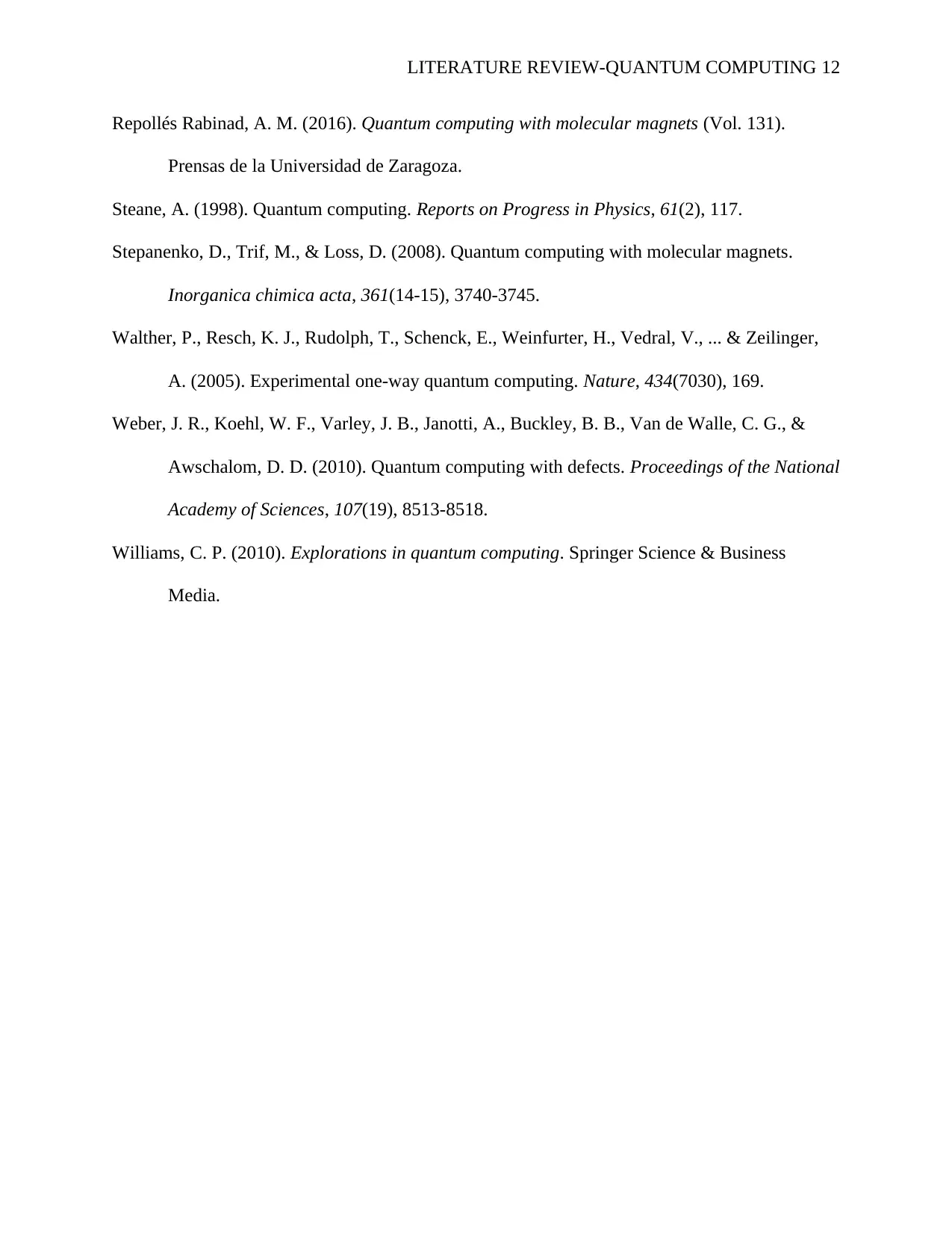
LITERATURE REVIEW-QUANTUM COMPUTING 12
Repollés Rabinad, A. M. (2016). Quantum computing with molecular magnets (Vol. 131).
Prensas de la Universidad de Zaragoza.
Steane, A. (1998). Quantum computing. Reports on Progress in Physics, 61(2), 117.
Stepanenko, D., Trif, M., & Loss, D. (2008). Quantum computing with molecular magnets.
Inorganica chimica acta, 361(14-15), 3740-3745.
Walther, P., Resch, K. J., Rudolph, T., Schenck, E., Weinfurter, H., Vedral, V., ... & Zeilinger,
A. (2005). Experimental one-way quantum computing. Nature, 434(7030), 169.
Weber, J. R., Koehl, W. F., Varley, J. B., Janotti, A., Buckley, B. B., Van de Walle, C. G., &
Awschalom, D. D. (2010). Quantum computing with defects. Proceedings of the National
Academy of Sciences, 107(19), 8513-8518.
Williams, C. P. (2010). Explorations in quantum computing. Springer Science & Business
Media.
Repollés Rabinad, A. M. (2016). Quantum computing with molecular magnets (Vol. 131).
Prensas de la Universidad de Zaragoza.
Steane, A. (1998). Quantum computing. Reports on Progress in Physics, 61(2), 117.
Stepanenko, D., Trif, M., & Loss, D. (2008). Quantum computing with molecular magnets.
Inorganica chimica acta, 361(14-15), 3740-3745.
Walther, P., Resch, K. J., Rudolph, T., Schenck, E., Weinfurter, H., Vedral, V., ... & Zeilinger,
A. (2005). Experimental one-way quantum computing. Nature, 434(7030), 169.
Weber, J. R., Koehl, W. F., Varley, J. B., Janotti, A., Buckley, B. B., Van de Walle, C. G., &
Awschalom, D. D. (2010). Quantum computing with defects. Proceedings of the National
Academy of Sciences, 107(19), 8513-8518.
Williams, C. P. (2010). Explorations in quantum computing. Springer Science & Business
Media.
⊘ This is a preview!⊘
Do you want full access?
Subscribe today to unlock all pages.

Trusted by 1+ million students worldwide
1 out of 12
Your All-in-One AI-Powered Toolkit for Academic Success.
+13062052269
info@desklib.com
Available 24*7 on WhatsApp / Email
![[object Object]](/_next/static/media/star-bottom.7253800d.svg)
Unlock your academic potential
Copyright © 2020–2025 A2Z Services. All Rights Reserved. Developed and managed by ZUCOL.
